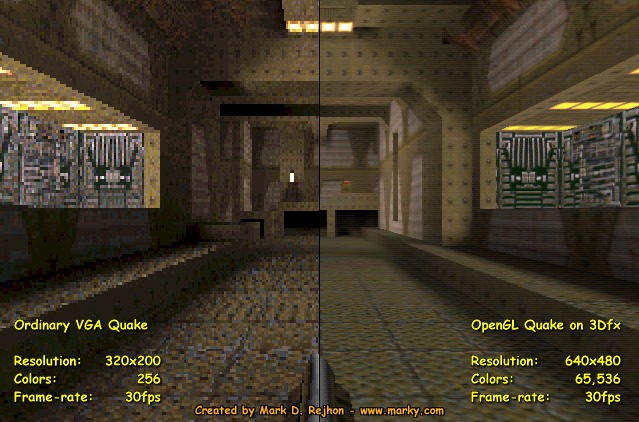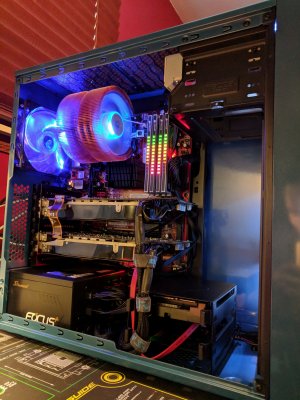jlbenedict
2[H]4U
- Joined
- May 22, 2005
- Messages
- 2,205
I know I voted Voodoo 2...and while probably not near the top of the list (but has been mentioned)-
Nvidia GTX 9x0 series
Nvidia GTX 9x0 series
Follow along with the video below to see how to install our site as a web app on your home screen.
Note: This feature may not be available in some browsers.
The 8800 GT wouldn't exist without the GTX. Bottom line is that G80 and the rest of the Tesla architecture allowed NVIDIA to rest on their laurels for four years, causing them to get complacent and releasing the Fermi turd.9700 9800 pro has to be #1. GTX 8800 was a great card, but I think 8800 GT was a better card in terms of price/performance. The Radeon 4850/4870 were the most underrated cards of all time considering the price / power / performance relative to Nvidia at the time. Best modern card has to be the 1080 ti.
3dfx Voodoo2 SLI
1024x768 at over 60fps in 1998-1999 in Quake 2 and Quake 3 Arena
The old days!
Honorary Mention: Tseng ET4000 VLB (VESA Local Bus, pre-AGP!) scorchingly fast at VGA and ran DOOM at 35fps reliably on a mere 486DX2-66 in 1993-1994. Before Matrox Millennium (Honorary Mention #2) came out!
I remember those Tseng cards! And VLB! Nothing ran flying toasters (After Dark) and cards falling at beating solitaire faster on our Dell 486/33 desktops at work. This was mid 1994 IIRC.
RE: Voodoo and Voodoo2...loved the speed of glide but hated the messed up fuzzy text caused by passing the output through them in 2D mode. At the time I was using a Matrox Millennium II with 8MB WRAM and at 1600x1200 at 85Hz it was tack sharp. Putting the V2 in line turned it into a fuzzy mess on the desktop. Even 100Hz at 1280x1024 was a mess. I was using a Hitachi 21" CRT at the time (from a SGI workstation, used a RGB input via 13W3).
And 1080ti cards! Wow still going strong after all these years. Paul Simon would approve. ;-)
I had a 9700 pro and would agree it was fast but played a game called Giants that locked up tighter than DC right now every time I played it. Hated it for that.

I’m gonna have to say 8800 GTX. There is simply no other card that comes to mind that was so dominant for so long. The feature set was state of the art, the cooling system was fairly exotic at the time, and ATi simply could not touch it for years. I’ve been in the game since the first 3D cards and without a doubt G80 was absolutely amazing.
Runner up is easily 9700/9800 pro/xt. R300 smacked Nvidia hard and R350 and R360 continued the pummeling. Trouble is, back in those days the next gen was always only ever about 6 months away and nvidia soon enough had the 6 series out which was an excellent comeback for the green team.
My pair of 8800 GTX lasted almost 7 years before dying. It is the longest stretch I've gone without a video card upgrade. I wouldn't be surprised if giving the GPU a reflow would bring them back to life. Lead-free solder can go to hell.8800s had major BGA solder issues though. Great cards, IF they lasted.
7970 is my pick for modern cards. My heavily OC'd (1.3GHz) one beat the next generation too, enough said.
1080Ti I think also needs honorable mention.
9700 Pro for obvious reasons.
Ditto except I was still using a Tseng Labs card up until I could convince my parents that a Geforce 256 32MB SDR would help my school work.I’m thinking about retracting my statement but only because I’ve realized that long have I forgotten about the transition from software rendering to dedicated 3D accelerators. There aren’t really words that described switching from a time of only 2d graphics to hardware accelerated 3d graphics.
My first 3d card purchase was a creative 8meg voodoo 2 but a year or so earlier I gamed on a friends voodoo 1 and I was blown away.
It’s hard to really pinpoint which card of that era could be the greatest of all time because that would be like suggesting the first car ever is the greatest because before then there were none.
Regardless, aside from my first 3d accelerated experiences, G80 created an era within the 3d gaming era. I would consider it the grandfather of the modern gpu.
So I really wanted to mention the Titan because it was the most expensive card I ever bought at the time, and was the first time I bought the bleeding edge card. And then just a few months later it was made obsolete by the 780ti. It was a good card for me, used for several years and replaced with a 980ti, but for that reason I could not nominate it.Radeon hasnt done anything very interesting since then, which leaves us to remaining Nvidia cards as yet unmentioned, so let me say the original GTX Titan

^^^ Yes to all above. I never see the Riva TNT 2 series get mentioned much? Was a pretty popular AGP chip.
#1 Radeon 9800 Pro / All in Wonder
#2 Voodoo 2
#3 Geforce 256
/Thread
You're welcome.
I’ll say Voodoo Banshee - the first card to combine 3D an 2d acceleration in one product. Pretty earth shattering at the time.
Wasn't the 9800 Pro just a slightly faster 9700 Pro with some optimizations?
Wasn't the 9800 Pro just a slightly faster 9700 Pro with some optimizations?
Wasn't the 9800 Pro just a slightly faster 9700 Pro with some optimizations?
If you mean 2D and 3D on a single card, that award goes to the Voodoo Rush. It was a dreadful card which put the Voodoo1 TMU and FBI behind the 2D chip and was accessed through linked registers on the 2D chip, either a Alliance or Hercules 2D core. This resulted in a stiff performance penalty, and later versions of the card were slightly overclocked to make up the difference. The Banshee was the first integrated 2D and 3D core on one piece of silicon for 3dfx.
The 9800 uses the R350 core, which is a further optimized version of the R300 core the 9700 used.
the 9700pro, when it dropped was a thermonuclear bomb in the GPU arena. It was so powerful, at a time where gpus were just starting to inch forward in resolution, and the now relegated MSAA ability to take away jagged lines. It was the first time, in videocard history, that you could actually kick on 4x or even 8x msaa and still get playable framerates at high resolutions. To talk about how game changing at the time this was, is hard to express for todays newer generations of pc gamers. The 9700pro actually gave you substantially game changing visual improvements in textures at higher resolutions, removal of jagged edges, and overall resolution. Nowadays new gpus simply offer slightly more fps compared to last gen with everything looking identical. There are no new 'wow' moments left when slotting in a new GPU, compared to measurements of old. Having a few more fps can't hold a candle to the massive visual overhaul the 9700pro ushered in for pc gaming.I'm no expert but, if you want to be that reductive than you could disqualify most of the cards in this thread thinking that.
reading 9800 pro reviews, it was barely faster than the last gen and the next nvidia card easily beat it. not sure why its on the list other than may be being affordable? Except adjusted for inflation, it was a $500 card.
You make a good point. I miss the days when you could actually save money and increase performance by buying two video cards. SLI was a value proposition, imagine that!The best I've had was GTX660 in SLI, it was faster than a 680 ultra, and didn't cost me half the price.
Second is the Radeon 5850, because it served me almost 3 years without having to upgrade.
Short lived, many paired it with a Voodoo 2, and D3D was new enough that it just didn't have the same impact.^^^ Yes to all above. I never see the Riva TNT 2 series get mentioned much? Was a pretty popular AGP chip.
This was the card that changed it all!3dfx Voodoo 2
Oddly enough, the first Nvidia card (NV1) came out BEFORE the Voodoo 1 did (by half a year). The concept was rumbling around - the NV1 just sucked, badly.This was the card that changed it all!
Then the voodoo3 &4 followed suit! There would literally be no Nvidea had it not been for 3DFX Period.
7970 "mature version" = GHz Edition, yes?When I think all time greats, the following come to mind through the years.
Voodoo 2, Radeon 9700 Pro, 8800 GTX, HD 7970 (mature version), GTX 1080 Ti.




Yes, thank you. They really should have led out the gate with this version, imo.7970 "mature version" = GHz Edition, yes?
View attachment 323361
https://www.techpowerup.com/gpu-specs/radeon-hd-7970-ghz-edition.c365
T&L was GeForce 256.I gotta gold old school on this. TNT2 or Voodoo2 as the GOAT. Both set the stage for everything we take advantage of today. T&L and Glide were both way more than marketing

Ah, where to begin? There are so many great GPUs to choose from!
Radeon Vega64
Radeon VII
Radeon RX 5700XT
Radeon 6000 series
RTX 3000 series